Many tourists' travel routes around Provence become routes in the footsteps of Nostradamus. One of the most mysterious people on the planet, who left behind predictions of future events for many centuries to come, was born, studied, worked and died in this fertile land. The legendary astrologer, alchemist, doctor and poet was born in Saint-Remy-de-Provence, and the end point of his life’s journey was the Salon de Provence.
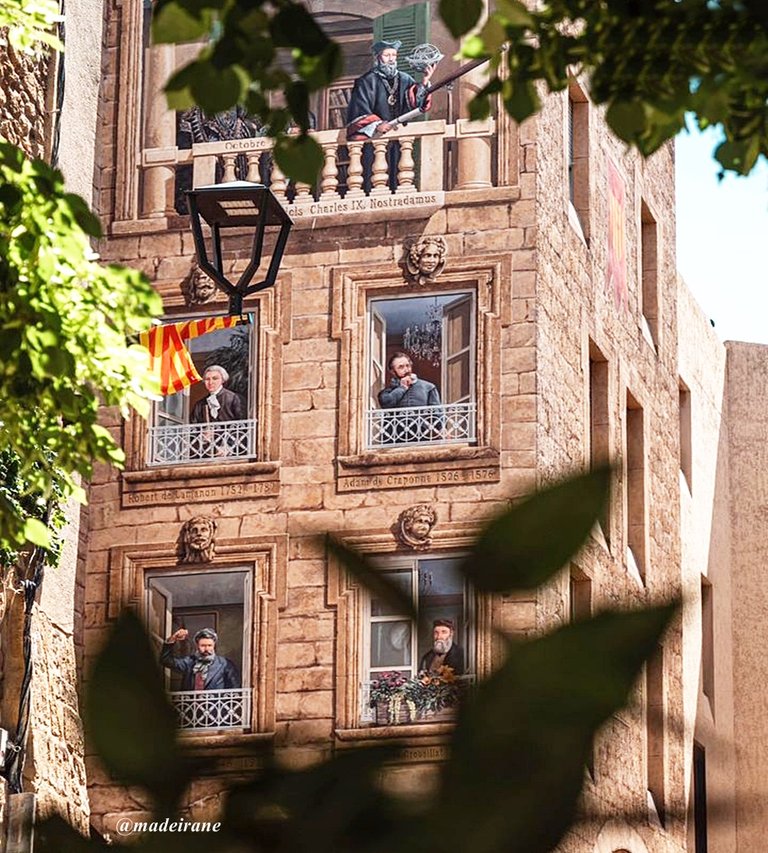
My husband and I found Salon de Provence plunged into deep hibernation. The streets and houses of the town dissolved in the afternoon heat. Compared to the busy Aix-en-Provence, Salon de Provence seemed quiet and uncrowded. The word "salon" appearing in its name should not be taken literally. The fact is, that during the time of the ancient Romans, a road passed through these regions along which salt was transported. And salt in Latin is called sal.
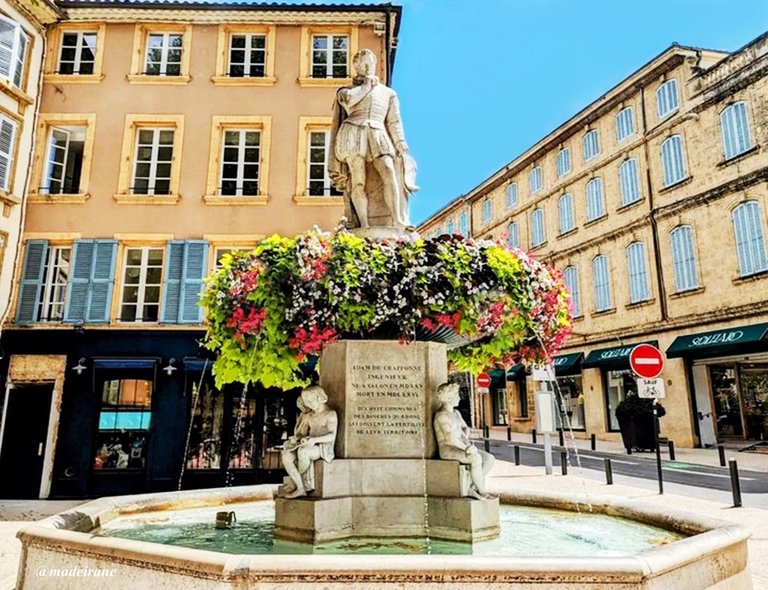
The historical center of Salon-de-Provence is compact and charming in a Provencal way. Narrow streets, sand and olive-colored houses - everything is in the regional spirit. The walls of some houses are decorated with frescoes.
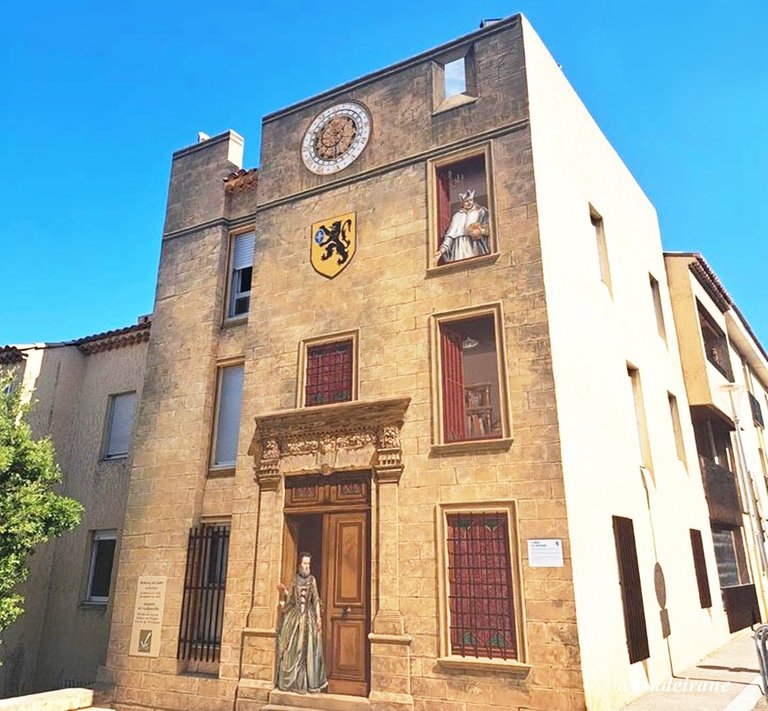
From the wider streets, unnoticed, you find yourself in the traditional old town's narrow streets, surrounded on both sides by long rows of houses. Even on seemingly deserted streets, there are cafes next to each other that will warmly welcome everyone who wants to replenish their strength.
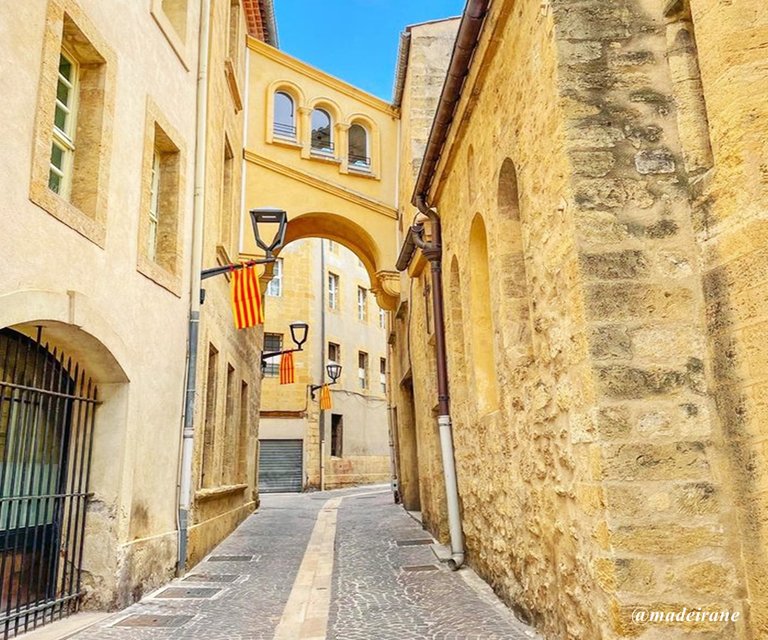
I would also like to note how the French know how to decorate facades, camouflage the concrete walls of houses or fences with green plants or flowers. After all, the mood immediately becomes different!
Gradually, the streets of the city lead us to the Clock Tower. This building has maintained its grandeur and beauty of form since its construction. It was built in the 17th century. We specifically examined the tower from two sides, since each of them has its own function. On the front side of the tower, you can track the phases of the moon. On the reverse side, facing the Old Town, a calendar of the days of the week is displayed. The sun drawn on it symbolizes Sunday, the Moon - Monday, Mars - Tuesday, Mercury - Wednesday, Jupiter - Thursday, Venus - Friday and Saturn - Saturday.
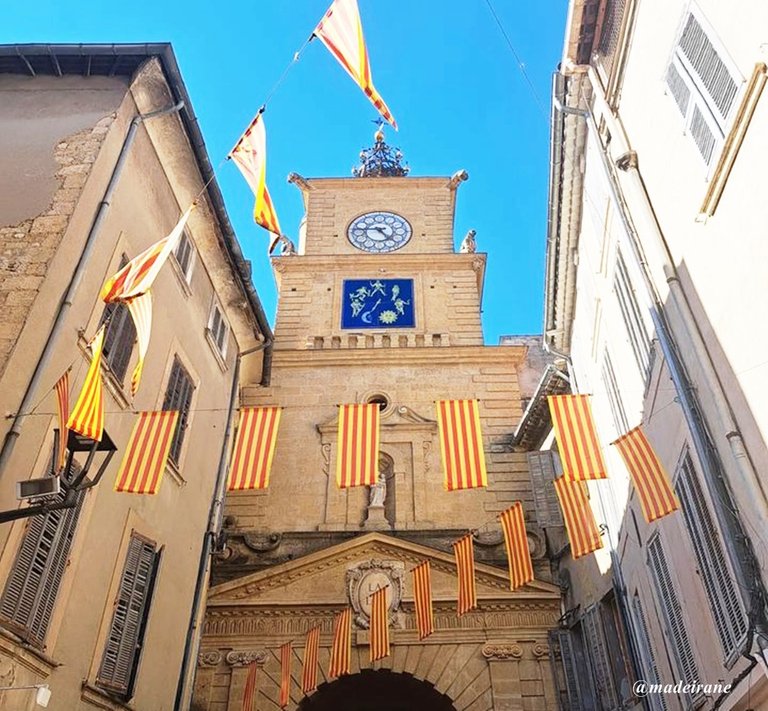
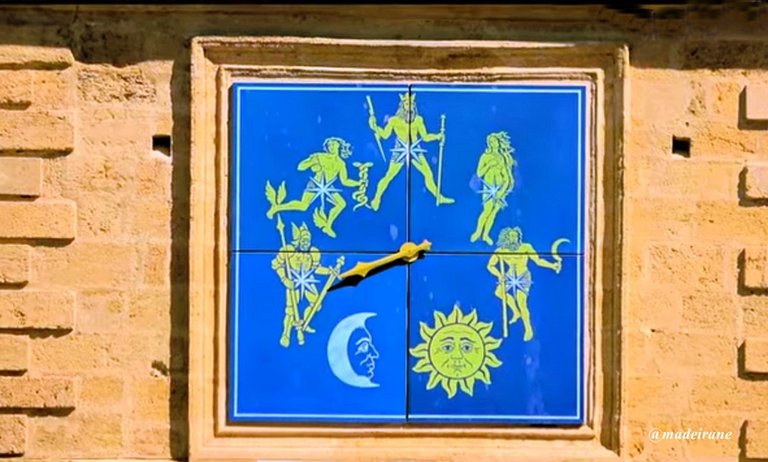
One of my favorite attractions in Provence is also located in this city. In front of the gates of the Clock Tower there is a fountain, “overgrown” with moss and herbs, looking like a giant green mushroom. The “mossy” fountain, which appeared in the 18th century, is one of the main symbols of the city.
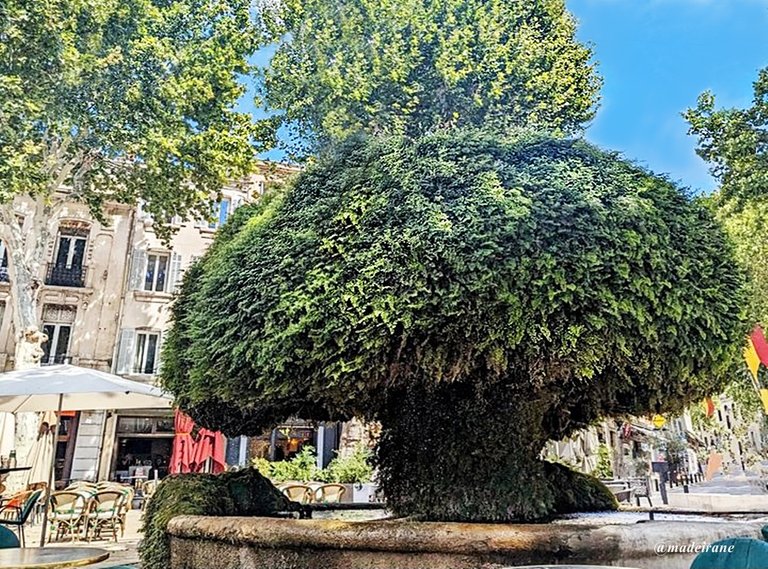
From the wall of a house on Clock Street, the first floor of which is occupied by a clothing store, the face of Nostradamus looks out at tourists. This huge fresco appeared in the 80th of the last century.

The appearance of the soothsayer depicted on it is inspired by the painting of the German artist Christian Wilhelm Ernst Dietrich “The Head of a Prophet” (18th century), about which it is not said anywhere that this prophet is Nostradamus. Usually, when creating images of Nostradamus, artists were guided by the portrait painted by his son Cesar, and the author or authors of the fresco, as they say, went their own way. The idea is good.
Nearby there is an abstract, faceless monument to Nostradamus.

In the house where Nostradamus spent the last 19 years of his life, and where the famous “Centuries” - predictions expressed in poetic form - saw the light, a museum has been opened. The entrance ticket for an adult was 5 EUR.
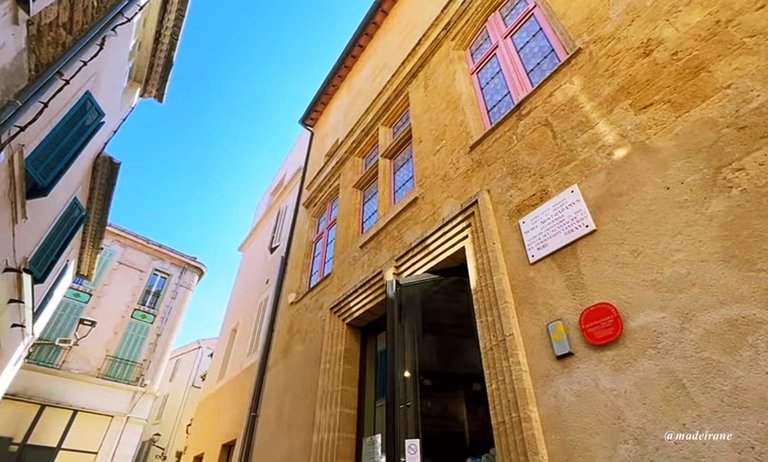
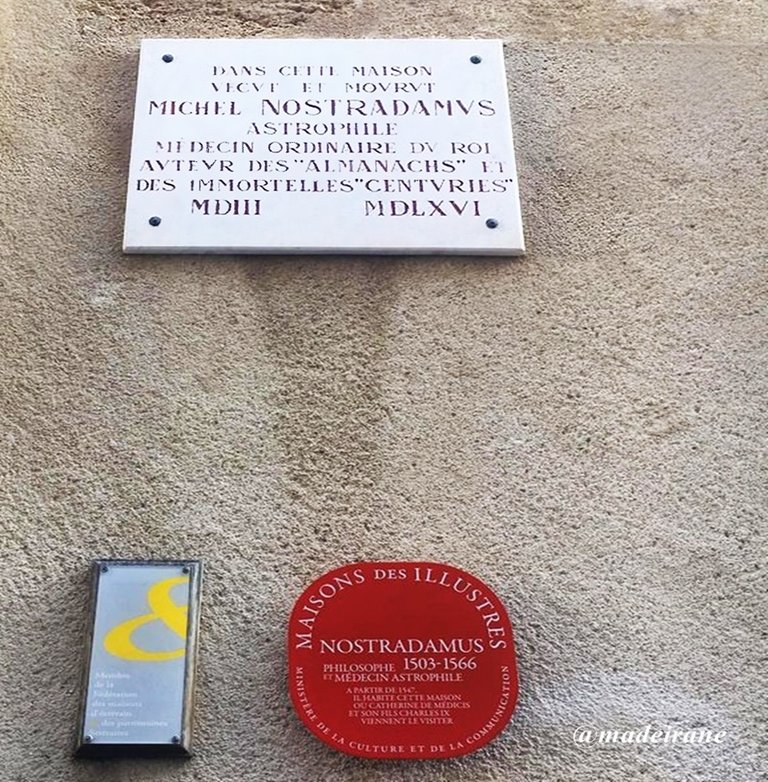
The lady sitting at the ticket office asked what country we were from and handed us an English-language description of the exhibition. Officially, photography was not allowed in the museum, but one of the attendants kindly allowed me to take a few shots without flash. By and large, all that remains of Nostradamus in the building are the walls. Everything else is wax figures, modern wall paintings, a few ancient books and astronomical instruments. Therefore, the presence of such prohibitive measures surprised me.

Well, let's switch to the 16th century - to our boy's early childhood. Michel de Notredame (he would be called Nostradamus later when he received his doctorate) came from a family of baptized Jews, very educated and wealthy people.
The wax figure in the frame is Nostradamus’s great-grandfather on his mother’s side, Jean de Saint-Rémy, who spent a lot of time with little Michel. And if we look at the facts, Jean de Saint-Rémy, who worked as a doctor, played a huge role in shaping the personality of his great-grandson. He told Michel about natural cycles and seasons, the stars in the sky, about ancient and modern wars and religious conflicts, about the wanderings of the Jewish people, and also taught him mathematics and revealed to him the secrets of Kabbalah.

This museum did not set out to recreate the life of Nostradamus and his family. On the other hand, due to such a long time ago and various historical cataclysms, I did not expect to find such pictures there.
The museum was created to show its visitors the personality of the predictor and some great moments of his career and life. I think the museum managed this task with a four-minus on a five-point scale. I give a minus because, carried away by creating an atmosphere of mystery, the designers of the halls darkened them too much.

A woman with a frozen gaze and the stamp of madness on her face symbolizes the attitude of a medieval person to the plague, from which the European population died at that time. By the way, the plague will not spare either Nostradamus’s first wife or his children from his first marriage. And for his services in saving the inhabitants of Aix-en-Provence from this terrible disease and for the creation of preventive medicines that helped fight this disease, Nostradamus will be awarded a lifelong pension from the authorities.
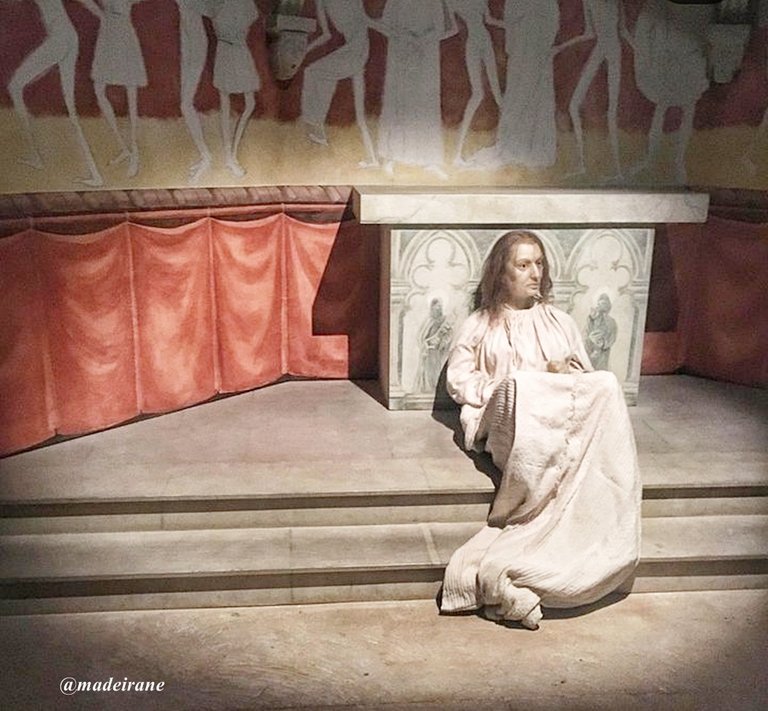
The figure of Catherine de Medici is not present here by chance: the French queen, who had a weakness for astrology and astrologers, turned to Nostradamus for advice and forecasts. The figure of Ekaterina was decorated by masters, in my opinion: it does not look very much like the preserved images of the queen.
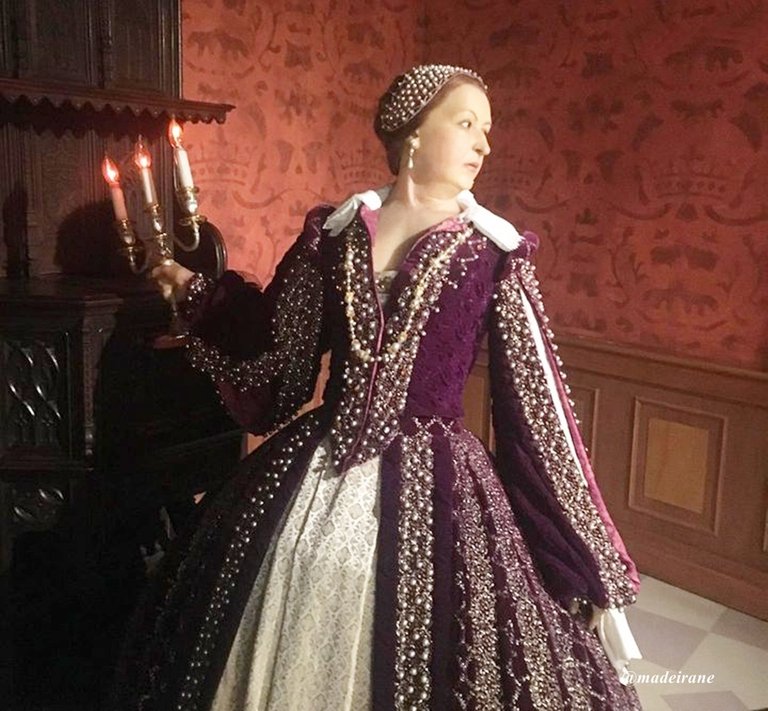
Residents of medieval Europe perceived the plague as the onset of the Apocalypse, as a terrible dance of death before the Last Judgment. And young Nostradamus, who witnessed this pan-European disaster, believed that it was too long and cruel for the manifestation of God's wrath. And he believed that such a difficult time would be replaced by a new era, where the will to live would triumph.
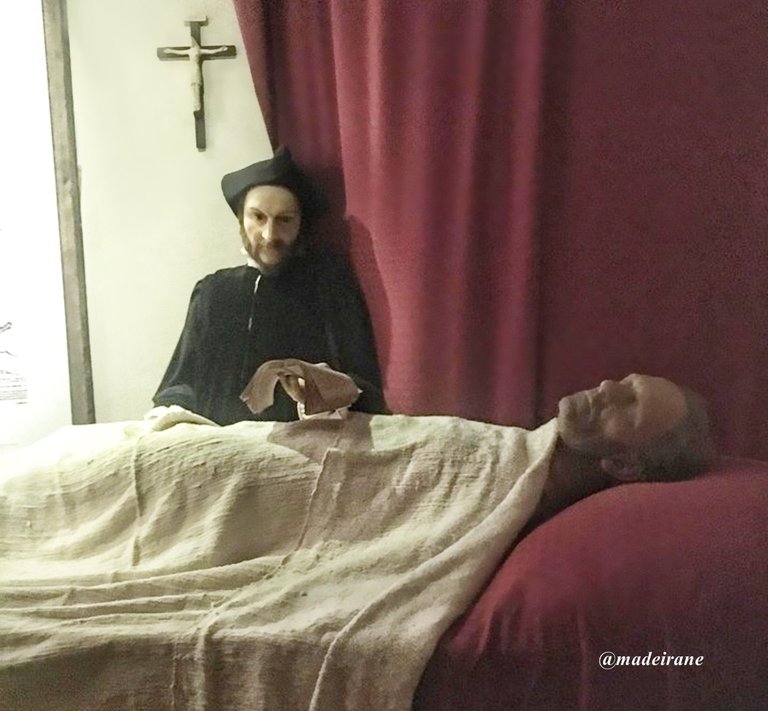
One of the parts of the exhibition is dedicated to the student years of Nostradamus.
Nostradamus is a real man of the Renaissance, with an indomitable thirst for knowledge, for the achievement of a new man with new knowledge of an atom». First, he studied in Avignon, where he received a master's degree in art, and then he graduated in media at Oppelle.

Nostradamus arrived in Salon-de-Provence at the age of 44, after the death of his first wife and children from the plague, interrogation by the Inquisition and long wanderings through Italy, Alsace and other cities of France. In Salon-de-Provence, he marries the young widow Anne de Ponsard. In this marriage he had six children. Having settled in Salon, Nostradamus becomes the owner of a hotel, publishes almanacs and invites hydraulic engineer de Crapon at his own expense to build a canal for the needs of the town. For the latter, by the way, Salon de Provence is deeply grateful to him. And, of course, Nostradamus continues to give his astrological consultations and was engaged in philosophy.
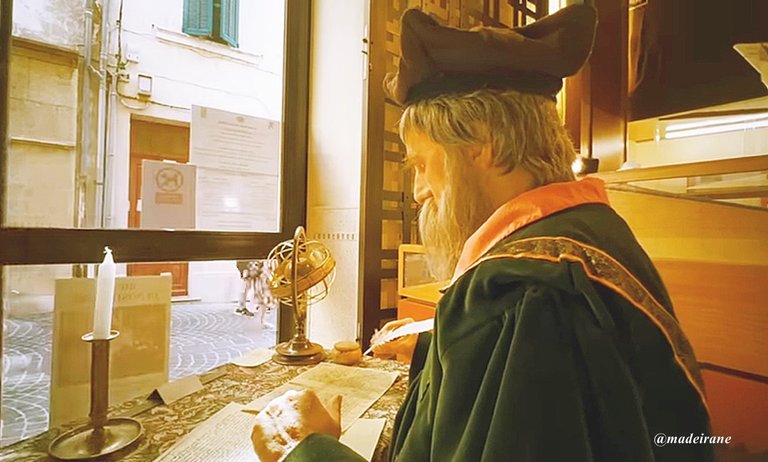
In 1555, “Centuries” were written - books with poetic predictions of the fate of different states and peoples, each of which consisted of one hundred quatrains. A sea of mysteries for future generations, a huge number of theories, interpretations and versions, fierce debates...
Next to the museum there is an interesting monument of Romanesque architecture - the Church of Saint-Michel (13th century). Unfortunately, its doors were closed. I note that Nostradamus is buried not in it, but in the Saint-Laure Cathedral, and we did not visit his grave.
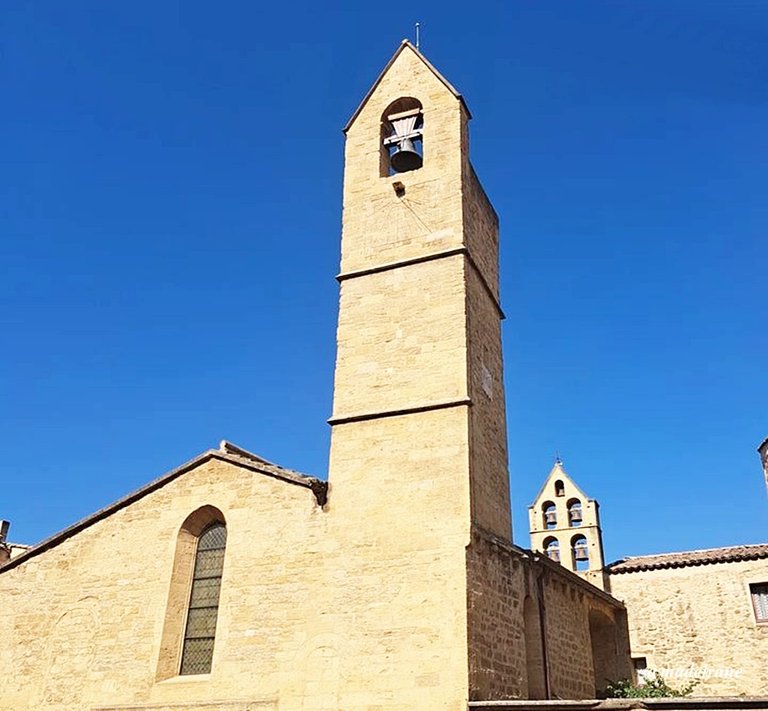
But the main purpose of our visit to Salon-de-Provence was not the Nostradamus Museum, but the large and gloomy castle of the Empire, towering over the historical center.
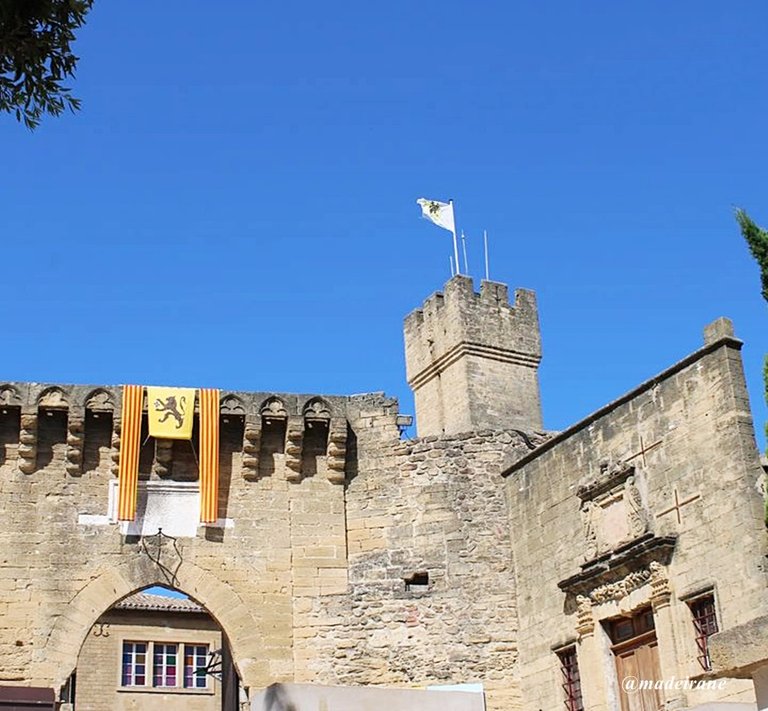
The castle was built from the 9th to the 13th centuries - for the bishops of Arles, since the city was their residence. It is one of the oldest castles in Provence region. Many country's monarchs visited it. As for us,not only the architecture and history of the castle interested us, but also its content.

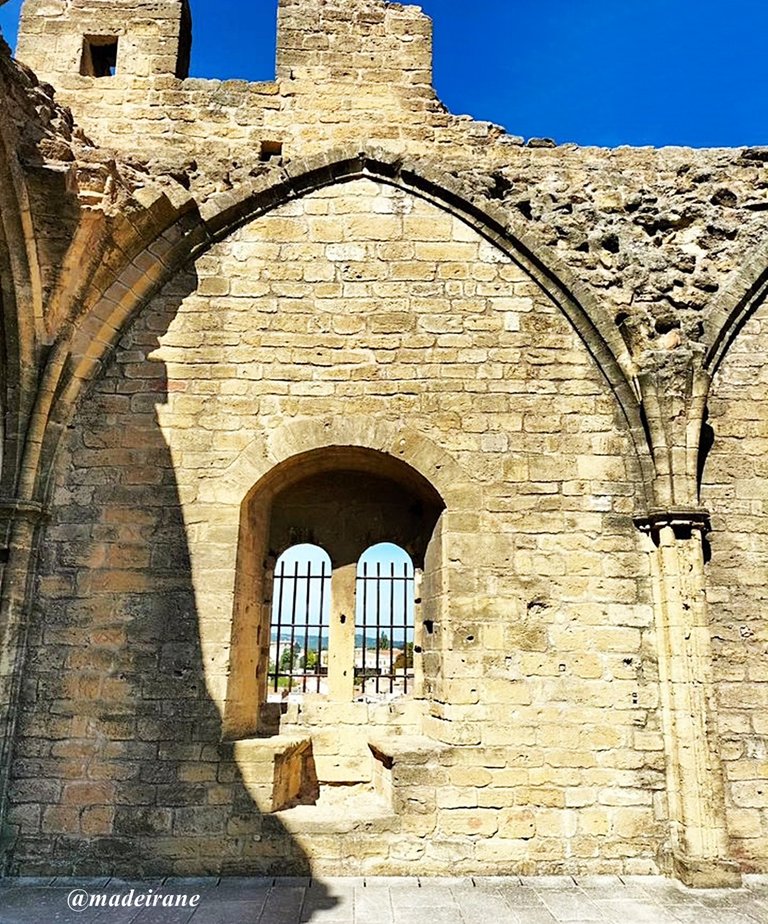
Museum houses the History of the French Army from the reign of Louis XIV until the outbreak of the First World War. Although, as we noticed already in the halls, some items (in particular, armor and a crossbow) date back to earlier centuries.
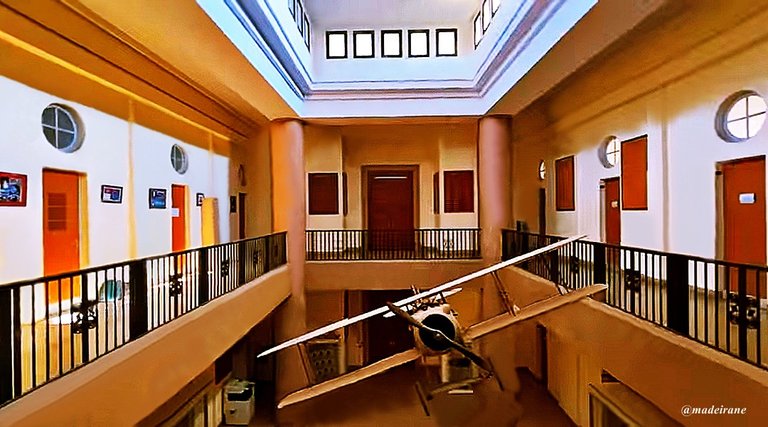
The collection of military-themed exhibits presented in this museum is considered the largest in France. The cost of tickets to visit the castle is the same as the cost of tickets to the Nostradamus Museum, i.e. 5 EUR per person. However, unlike the Nostradamus Museum, the Empire Castle displays genuine, unique objects that are not “far-fetched” to the “character”. And, besides, here you can take photos as much as you want and in any way you want.
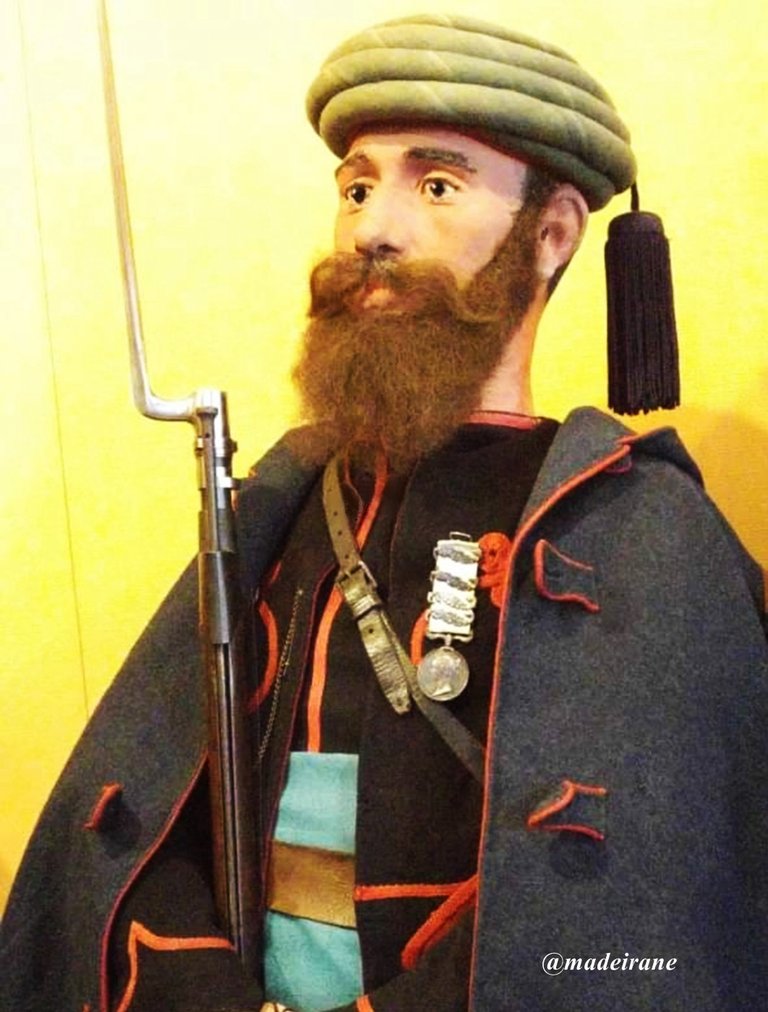
The exhibits in the castle were collected by collectors Raoul and Jean Brunon. The collection was transferred to the French state in the late 60th of the twentieth century.
What appeals to me about the collection is its idea. This is not the typical armory of rarities that we often see in many museums. Although at first, when knightly armor appeared before my eyes, I thought that we were in for a traditional gentleman’s set, seen dozens of times in other cities and countries.
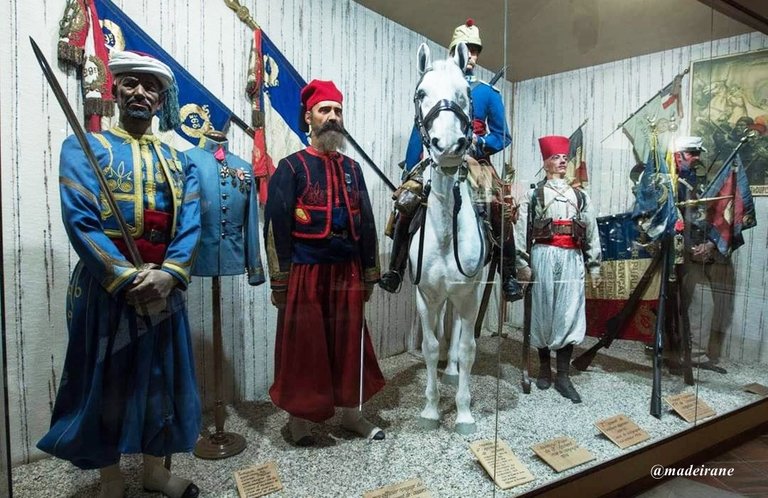
But I soon realized being wrong. Salon de Provence created an interesting museum of the French military campaigns' history, reflected the war in art, showed the evolution of military uniforms and military equipments. We also see the collection of paintings, documents, maps, and valuable personal items.
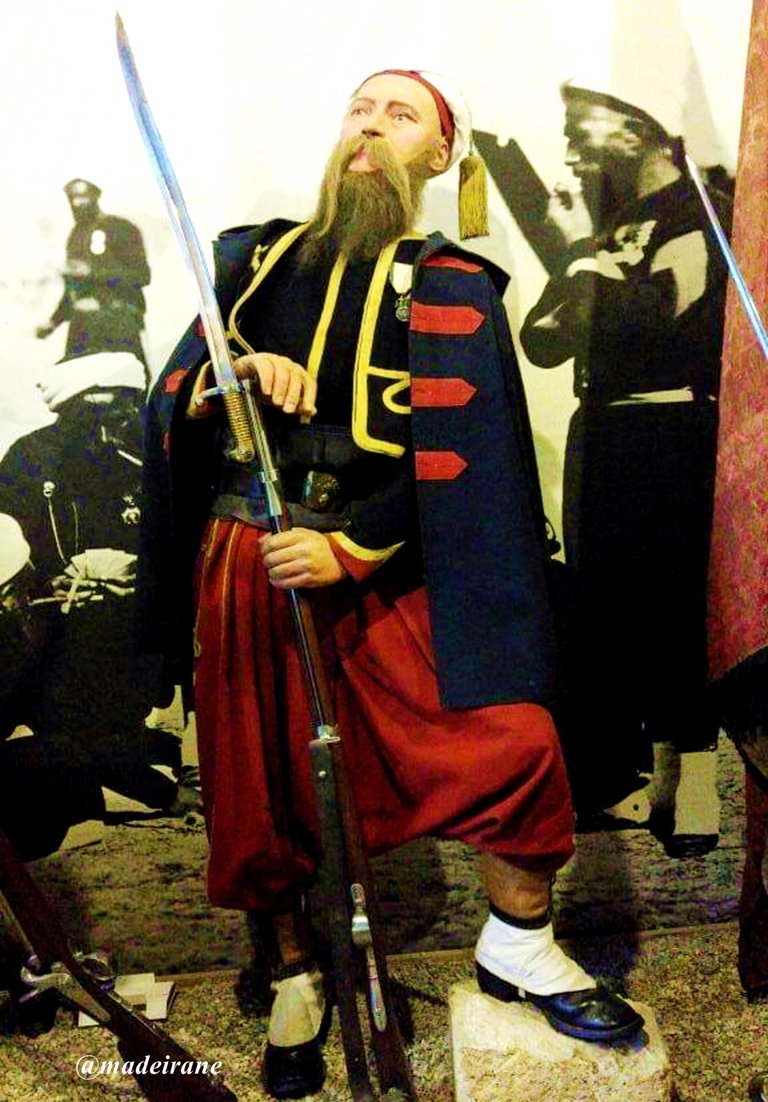
I liked the fact that much attention was paid to the history of military clothing in the exhibition. The windows are literally filled with mannequins dressed in military uniforms. This is actually a “living” encyclopedia of the wardrobe of high, middle and low army ranks from different times. And the mannequins themselves are made with soul: it’s simply impossible to tear yourself away from their faces. A whole gallery of characters!

Leaving the museum, we paused for a minute at the top of the stairs leading to the castle. I won’t say that the view of the Salon de Provence from it is amazing, but there is something attractive about this group of light-colored houses with tiled roofs and olive-colored shutters.
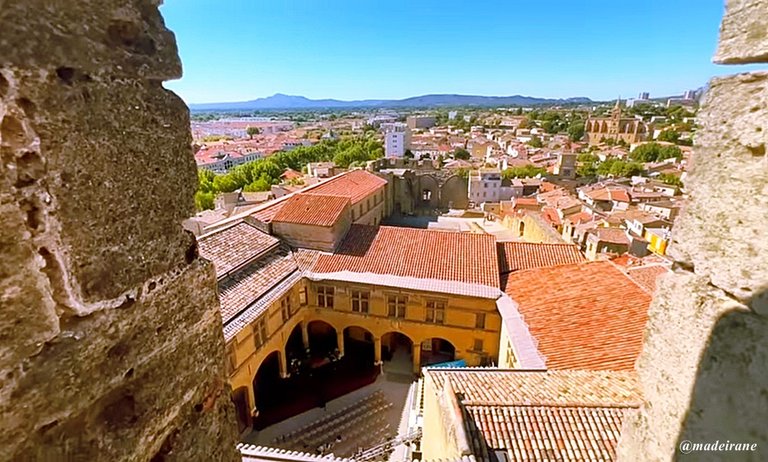
A sweet and modest ancient city that managed to contain a lot of mysticism, a little architecture and a lot of stories related to the French wars - that’s how I would sum up our visit to Salon de Provence in one sentence.
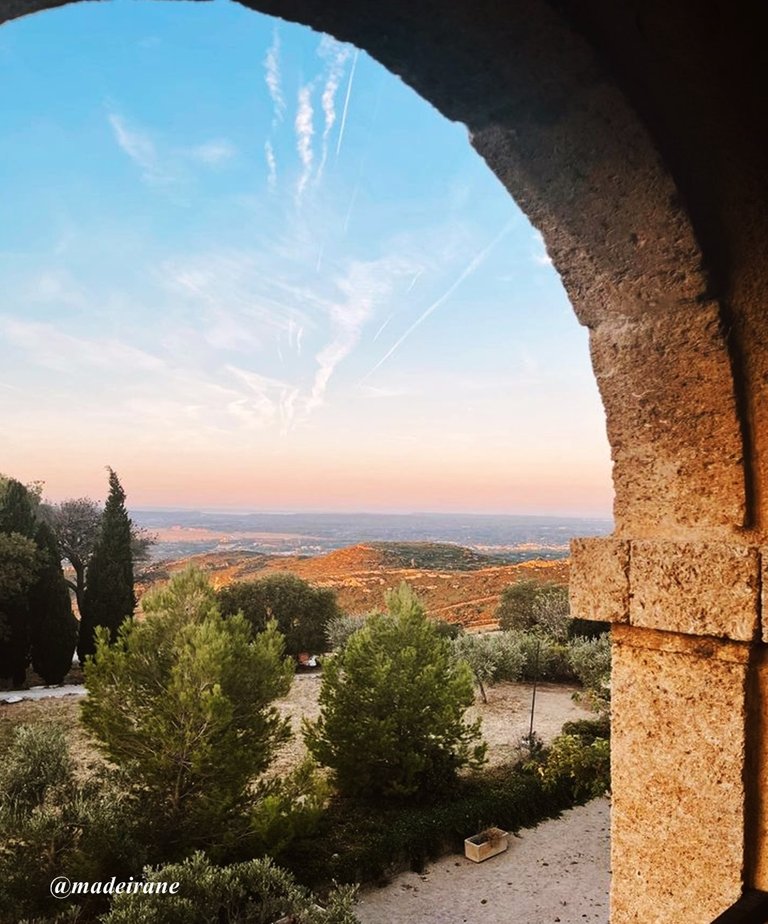
💝💝💝💝💝💝💝💝💝💝
With love, @madeirane
© 2024
Daugelio turistų kelionių po Provansą maršrutai tampa Nostradamo pėdsakais. Šiame derlingame krašte gimė, mokėsi, dirbo ir mirė vienas paslaptingiausių planetos žmonių, palikęs ateities įvykių pranašysčių daugeliui šimtmečių į priekį. Legendinis astrologas, alchemikas, gydytojas ir poetas gimė Saint-Rémy-de-Provence, o jo gyvenimo kelionės galutinis taškas buvo Provanso salonas.
Mes su vyru radome Provanso saloną nugrimzdusį į gilią žiemos miegą. Miestelio gatvės ir namai ištirpo popietės karštyje. Palyginti su judriuoju Aix-en-Provence'u, Salon de Provence atrodė ramus ir neperpildytas. Jo pavadinime esančio žodžio "salonas" nereikėtų suprasti pažodžiui. Tiesa ta, kad senovės romėnų laikais per šiuos regionus ėjo kelias, kuriuo buvo gabenama druska. O druska lotyniškai vadinama sal.
Istorinis Salon-de-Provanso centras yra kompaktiškas ir žavus provanso stiliumi. Siauros gatvelės, smėlis ir alyvuogių spalvos namai - viskas atitinka regiono dvasią. Kai kurių namų sienas puošia freskos.
Iš platesnių gatvių nepastebimai atsidursite tradicinėse senamiesčio siaurose gatvelėse, kurias iš abiejų pusių supa ilgos namų eilės. Net ir iš pažiūros apleistose gatvėse viena šalia kitos įsikūrusios kavinės šiltai priims kiekvieną, norintį papildyti jėgas.
Taip pat norėčiau atkreipti dėmesį į tai, kaip prancūzai moka puošti fasadus, maskuoti betonines namų sienas ar tvoras žaliais augalais ar gėlėmis. Juk nuotaika iškart tampa kitokia!
Pamažu miesto gatvės mus veda prie Laikrodžio bokšto. Šis pastatas nuo pat pastatymo išlaikė savo didybę ir formų grožį. Jis pastatytas XVII amžiuje. Specialiai apžiūrėjome bokštą iš dviejų pusių, nes kiekviena jų atlieka savo funkciją. Priekinėje bokšto pusėje galima stebėti mėnulio fazes. Kitoje pusėje, nukreiptoje į senamiestį, rodomas savaitės dienų kalendorius. Jame nupiešta saulė simbolizuoja sekmadienį, Mėnulis - pirmadienį, Marsas - antradienį, Merkurijus - trečiadienį, Jupiteris - ketvirtadienį, Venera - penktadienį, o Saturnas - šeštadienį.
Šiame mieste yra ir viena iš mano mėgstamiausių Provanso lankytinų vietų. Priešais laikrodžio bokšto vartus yra fontanas, "apaugęs" samanomis ir žolelėmis, atrodantis kaip milžiniškas žalias grybas. XVIII a. atsiradęs "samanų" fontanas yra vienas pagrindinių miesto simbolių.
Nuo Laikrodžių gatvėje esančio namo, kurio pirmame aukšte įsikūrusi drabužių parduotuvė, sienos į turistus žvelgia Nostradamo veidas. Ši didžiulė freska atsirado praėjusio amžiaus 80-aisiais metais.
Jame pavaizduoto pranašo išvaizdą "įkvėpė" vokiečių dailininko Christiano Wilhelmo Ernsto Dietricho paveikslas "Pranašo galva" (XVIII a.), apie kurį niekur nesakoma, kad šis pranašas yra Nostradamas. Paprastai, kurdami Nostradamo atvaizdus, dailininkai vadovaudavosi jo sūnaus Cezario nutapytu portretu, o freskos autorius ar autoriai, kaip sakoma, ėjo savo keliu. Tačiau kaip ten bebūtų, idėja gera.
Netoliese stovi abstraktus, beveidis paminklas Nostradamui. Jis manęs visai nesudomino.
Namuose, kuriuose Nostradamas praleido paskutiniuosius 19 savo gyvenimo metų ir kuriuose šviesą išvydo garsieji "Šimtmečiai" - poetine forma išreikštos pranašystės, atidarytas muziejus. Įėjimo bilietas suaugusiajam kainavo 5 eurus.
Prie kasos sėdinti moteris paklausė, iš kokios šalies esame, ir įteikė mums anglišką ekspozicijos aprašymą. Oficialiai muziejuje fotografuoti buvo draudžiama, tačiau viena iš prižiūrėtojų maloniai leido man padaryti keletą kadrų be blykstės. Apskritai iš Nostradamo pastato liko tik sienos. Visa kita - vaškinės figūros, šiuolaikinė sienų tapyba, kelios senovinės knygos ir astronominiai prietaisai. Todėl tokių draudžiamųjų priemonių buvimas mane nustebino.
Persikelkime į XVI amžių - į ankstyvąją mūsų berniuko vaikystę. Mišelis de Notredamas (vėliau, gavęs daktaro laipsnį, jis bus vadinamas Nostradamu) buvo kilęs iš pakrikštytų žydų, labai išsilavinusių ir turtingų žmonių, šeimos.
Žanas de Sent-Remis, dirbęs gydytoju, atliko didžiulį vaidmenį formuojant savo anūko asmenybę. Jis pasakojo Mišeliui apie gamtos ciklus ir metų laikus, žvaigždes danguje, apie senovės ir šiuolaikinius karus ir religinius konfliktus, apie žydų tautos klajones, taip pat mokė jį matematikos ir atskleidė Kabalos paslaptis.
Norėčiau pabrėžti, kad šis muziejus nesiekė atkurti Nostradamo ir jo šeimos gyvenimo. Kita vertus, dėl tokio ilgo laiko ir įvairių istorinių kataklizmų nesitikėjau ten rasti tokių paveikslų.
Muziejaus užduotis iš esmės kitokia - suteikti lankytojams žinių apie mokslininko prognozuotojo asmenybę, išryškinant tam tikrus svarbiausius jo karjeros ir gyvenimo momentus. Manau, kad muziejus su šia užduotimi susidorojo su keturiais minusais penkiabalėje skalėje. Minusą skiriu dėl to, kad, pagauti paslapties atmosferos kūrimo, dizaineriai sales per daug užtamsino.
Moteris su sustingusiu žvilgsniu ir beprotybės antspaudu ant veido simbolizuoja viduramžių žmogaus požiūrį į marą, nuo kurio tuo metu mirė Europos gyventojai. Beje, maras nepasigailės nei pirmosios Nostradamo žmonos, nei jo vaikų iš pirmosios santuokos. O už nuopelnus gelbstint Aix-en-Provence'o gyventojus nuo šios baisios ligos ir už prevencinių vaistų, padėjusių kovoti su šia liga, sukūrimą Nostradamas iš valdžios institucijų gaus pensiją visam gyvenimui.
Jekaterina Mediči čia figūruoja neatsitiktinai: Prancūzijos karalienė, turėjusi silpnybę astrologijai ir astrologams, kreipėsi į Nostradamą patarimų ir prognozių. Jekaterinos figūrą, mano nuomone, puošė meistrai: ji nelabai panaši į išlikusius karalienės atvaizdus.
Viduramžių Europos gyventojai marą suvokė kaip Apokalipsės pradžią, kaip baisų mirties šokį prieš Paskutinįjį teismą. Todėl virš moters vaškinės figūros galvos piešiami šokantys skeletai. Jų kontūrai periodiškai paryškinami mėlyna spalva.
O jaunasis Nostradamas, matęs šią visos Europos nelaimę, manė, kad ji buvo pernelyg ilga ir žiauri Dievo rūstybės pasireiškimui. Ir jis tikėjo, kad tokį sunkų laiką pakeis nauja era, kurioje triumfuos valia gyventi.
Viena iš parodos dalių skirta Nostradamo studijų metams.
Nostradamas yra tikras Renesanso žmogus, turintis nenumaldomą žinių troškimą, siekiantis sukurti naują žmogų su naujomis žiniomis apie atomą". Pirmiausia Nostradamas studijavo Avinjone, kur įgijo dailės magistro laipsnį, o vėliau baigė medijų studijas Opelyje.
Nostradamas atvyko į Salon-de-Provansą būdamas 44 metų, po pirmosios žmonos ir vaikų mirties nuo maro, inkvizicijos tardymų ir ilgų klajonių po Italiją, Elzasą ir kitus Prancūzijos miestus. Salon-de-Provanse jis susituokia su jauna našle Anne de Ponsard. Šioje santuokoje susilaukia šešių vaikų. Apsigyvenęs Salone, Nostradamas tampa viešbučio savininku, leidžia almanachus ir savo lėšomis pakviečia hidrotechniką de Craponą pastatyti kanalą miesto reikmėms. Už pastarąjį, beje, Salon de Provence jam labai dėkingas. Ir, žinoma, Nostradamas toliau teikia astrologines konsultacijas, užsiima filosofija ir ezoterika.
1555 m. bus parašyti "Šimtmečiai" - knygos su poetinėmis įvairių valstybių ir tautų likimo prognozėmis, kurių kiekvieną sudarė šimtas ketureilių. Jūra paslapčių ateities kartoms, daugybė teorijų, interpretacijų ir versijų, aršios diskusijos...
Šalia muziejaus yra įdomus romaninės architektūros paminklas - Sen Mišelio bažnyčia (XIII a.). Deja, jos durys uždarytos. Atkreipiu dėmesį, kad Nostradamas palaidotas ne joje, o Saint-Laure katedroje, ir mes jo kapo nelankėme.
Tačiau pagrindinis mūsų apsilankymo Salon-de-Provanse tikslas buvo ne Nostradamo muziejus, o didelė ir niūri Imperijos pilis, iškilusi virš istorinio centro.
Pilis buvo pastatyta IX-XIII a. - Arlio vyskupams, nes miestas buvo jų rezidencija. Tai viena seniausių Provanso pilių, kurią aplankė daugelis šalies monarchų. Mus domino ne tik pilies architektūra ir istorija, bet ir jos turinys.
Mat joje įsikūręs Prancūzijos kariuomenės istorijos muziejus nuo Liudviko XIV laikų iki Pirmojo pasaulinio karo pradžios. Nors, kaip pastebėjome jau salėse, kai kurie daiktai (ypač šarvai ir arbaletas) datuojami ankstesniais amžiais.
Šiame muziejuje sukaupta karinės tematikos eksponatų kolekcija laikoma didžiausia Prancūzijoje. Bilietai į pilį kainuoja tiek pat, kiek ir į Nostradamo muziejų, t. y. 5 EUR asmeniui. Tačiau, skirtingai nei Nostradamo muziejuje, Imperijos pilyje eksponuojami tikri, unikalūs, "personažui" neperšami daiktai. Be to, čia galite fotografuoti kiek norite ir kaip norite.
Pilyje eksponuojamus eksponatus surinko kolekcininkai Raulas ir Žanas Brunonai. Kolekcija XX a. 60-ųjų pabaigoje buvo perduota Prancūzijos valstybei.
Kolekcija mane žavi savo idėja. Tai nėra tipiškas raritetų arsenalas, kurį dažnai matome daugelyje muziejų. Nors iš pradžių, kai prieš akis pasirodė riterių šarvai, pamaniau, kad prieš akis turime tradicinį džentelmeno rinkinį, dešimtis kartų matytą kituose miestuose ir šalyse.
Tačiau netrukus supratau klydusi. Provanso salone įkurtas įdomus Prancūzijos karinių kampanijų istorijos muziejus, karas atspindėtas mene, parodyta karinių uniformų ir karinės įrangos raida. Taip pat apžiūrėjome paveikslų, dokumentų, žemėlapių ir vertingų asmeninių daiktų kolekciją.
Man patiko, kad parodoje daug dėmesio skirta karinės aprangos istorijai. Vitrinos tiesiog pripildytos manekenų, apsirengusių karinėmis uniformomis. Tai iš tikrųjų "gyvoji" įvairių laikų aukštųjų, viduriniųjų ir žemųjų kariuomenės laipsnių karių garderobo enciklopedija. O ir patys manekenai sukurti su siela: nuo jų veidų tiesiog neįmanoma atsiplėšti. Visa galerija personažų!
Išeidami iš muziejaus, minutėlei sustojome laiptų, vedančių į pilį, viršuje. Nesakysiu, kad nuo jos atsiveria nuostabus Provanso salono vaizdas, tačiau ši šviesių namų su čerpių stogais ir alyvuogių spalvos langinėmis grupė kažkuo patraukli.
Mielas ir kuklus senovinis miestas, kuriame pavyko sutalpinti daug mistikos, šiek tiek architektūros ir daug istorijų, susijusių su Prancūzijos karais - taip vienu sakiniu apibendrinčiau mūsų apsilankymą Salon de Provanse.
Translated with DeepL.com (free version).
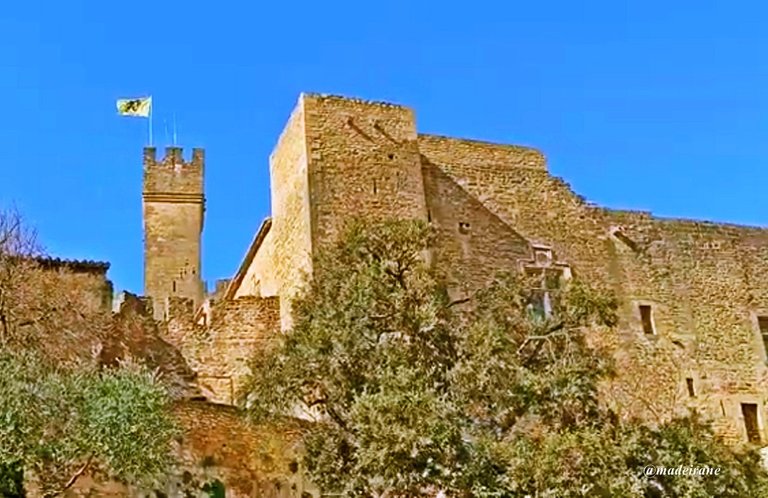
Amazing post! I was in Provence about 20 years ago. This country is very beautiful. A village that has managed to maintain the architecture of its origins
Congratulations, your post has been added to Pinmapple! 🎉🥳🍍
Did you know you have your own profile map?
And every post has their own map too!
Want to have your post on the map too?
Hi @madeirane, this city really is beautiful, it has great architectural works that are very well preserved, the clock is my favorite part looks imposing and striking.
Greetings!
Congratulations @madeirane! You have completed the following achievement on the Hive blockchain And have been rewarded with New badge(s)
Your next target is to reach 300 replies.
You can view your badges on your board and compare yourself to others in the Ranking
If you no longer want to receive notifications, reply to this comment with the word
STOPCheck out our last posts:
Your detailed exploration of Salon-de-Provence and the engaging narrative make for an excellent travelogue. It's always a pleasure to learn about a place through the eyes of a traveler. Thank you for sharing your experiences, and I'm looking forward to more of your travel stories!
Congratulations @madeirane! Your post brought a smile to the TravelFeed team so we have sent you a smiley. Keep up the good job. 🙂
Thanks for using TravelFeed!
@for91days (TravelFeed team)
PS: TravelFeed is in social media to reach more people, follow us on Facebook, Instagram, and Twitter.